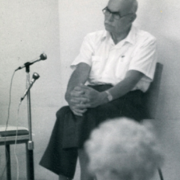Introduction “A memoir of the future”
It is owing to Claudio Neri’s inspired intuition that we were able to plan this fascinating issue of Funzionegamma on Bion’s Memoir of the Future (hereafter MoF). Inspired for many reasons. Firstly, as a result of the literature’s curious scarcity of works on the Trilogy; and then, because the paradigm prompted by Bion is becoming increasingly well known among psychoanalysts – and moreover in a version that places Italian authors in the forefront; and finally, because focusing on MoF means the undertaking of a theoretical activity. Bion’s three volumes are not only of deep interest in terms of the author’s biography, or even only in function of a better understanding of his theoretical concepts, but rather can be considered, for all intents and purposes, the final chapter of an ingenious creative enterprise – not a mere summary or appendix, but a whole new chapter.
Readers will find ample justification for this assertion of mine in all the works included in this issue. I would mention, given that some consider it a sign of Bion’s psychic decline, that perhaps only now that we have got some perspective are we able to appreciate its value. In these texts, admittedly presented as the recounting of a long dream, Bion once again shows his diabolical ability to disorient his readers, forcing them to wrack their brains and thus to think with their own minds. Diabolical because, in this tenaciousness there is something infernal, a quality that psychoanalysis must always possess, and also something provocative – but what Bion aims to generate is courage.
We must always remember this key aspect in his thinking – a thinking that is never static – and all the more so now that it has finally been embraced (even normalised). There is always the risk of making a sterile collection of formulas of it, with the resulting loss of its pervasive deconstructive impetus. Thus, what MoF highlights is the notion of the dream as a narrative activity. We are called upon to dream with him in a swirling vortex of images, stories, characters and quotations. It is the mind at work, the space of dream, peopled with his presences, at once shadowy and hyper-luminous.
The narrative form reminds us that after the failure of positivism we were left with our rhetorical truths. The only truths we have are those that we manage to construct consensually through language, they cannot exist outside of it. Creating meaning is narration, it could not be otherwise, and narrating is not only narrating, but also depicting. In turn, depiction removes the individual from the anguish provoked by the immense forces of nature but, as any Romanticist painting inspired on the sublime, while never ceasing to shock, does so in a way that no longer threatens and permits the viewer to observe the spectacle from a safe distance.
Nevertheless, if we judge the text according to the categories of fictional narrative, we could not consider it successful. The echoes of Beckett, in some places inspiring, are not enough. On the other hand, if we read it as analysts, i.e. as persons with a passion for the field of science invented by Freud (analysis, Ogden writes, is a form of human relating that did not previously exist, something both simple and enormous), these pages become an infinite fount of precious suggestions. The field of psychoanalysis feeds deeply on writings, but it is also the empirical field of encounter and of a caring practice, and cannot do without this duality. And if we stop and think about it, the purely narrative works of even famous analysts almost always bore and disappoint us because they are not nurtured directly on the analysts’ lifeblood, their experience, nor on efforts to frame that experience in theory – that lifeblood which, on the other hand, circulates abundantly in MoF.






